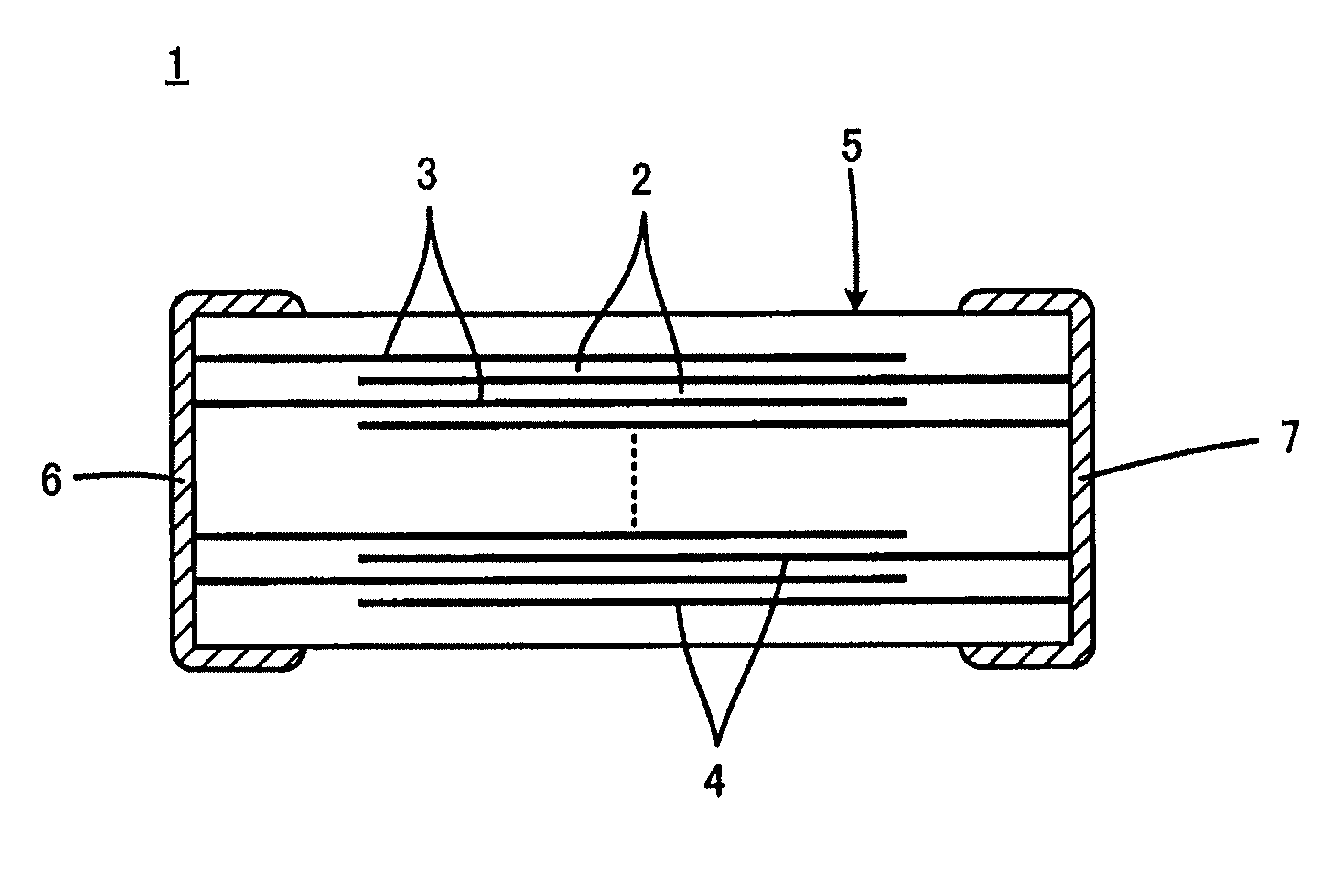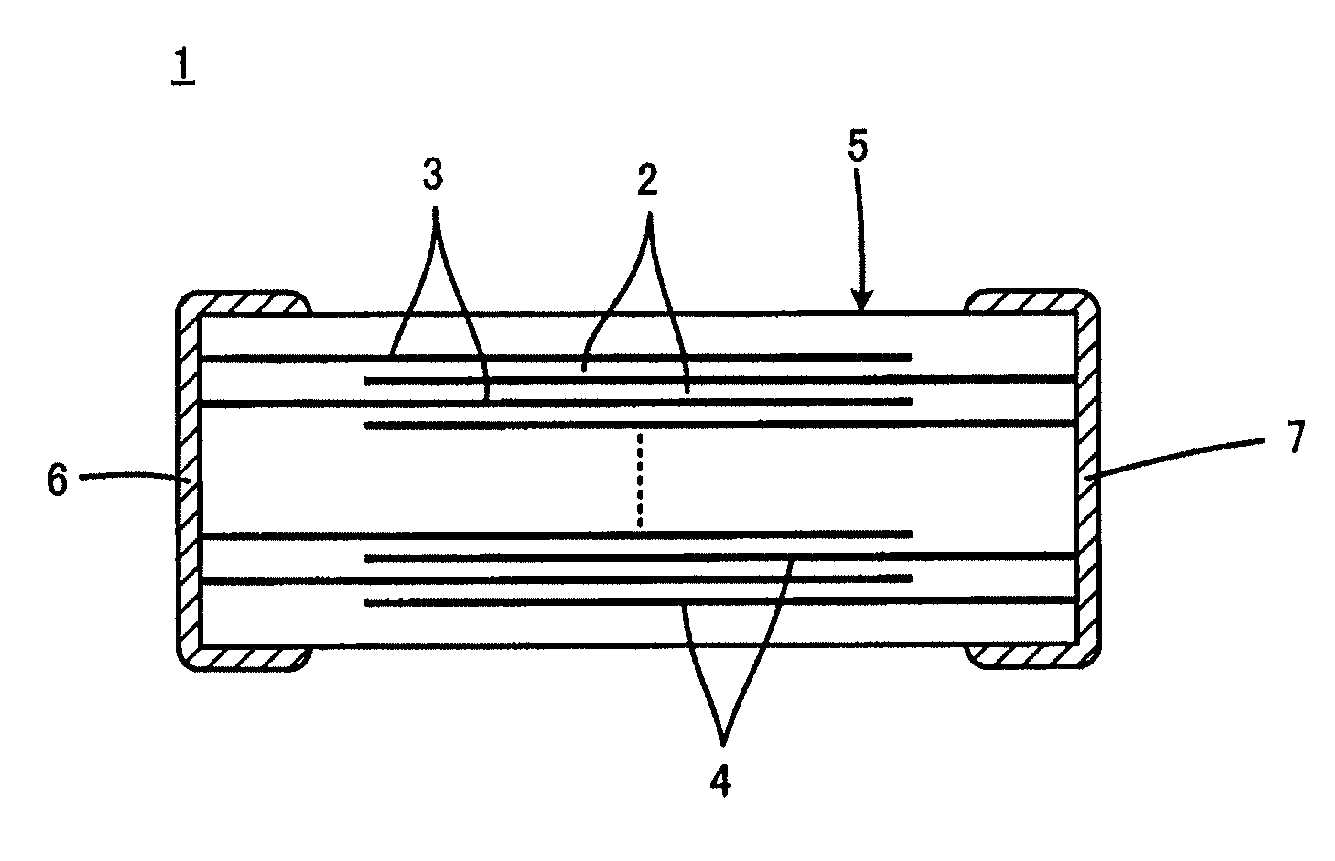Dielectric ceramic and laminated ceramic capacitor
a technology of dielectric ceramic and laminated ceramic, which is applied in the direction of fixed capacitors, inorganic chemistry, electrical apparatus, etc., can solve the problems of reducing the resistance to dielectric ceramic reduction, reducing the configuration difficulty of capacitors, and not always suitable for constituting dielectric ceramic layers. , to achieve the effect of improving the dielectric constant, increasing the dielectric constant, and reducing the calcination temperatur
- Summary
- Abstract
- Description
- Claims
- Application Information
AI Technical Summary
Benefits of technology
Problems solved by technology
Method used
Image
Examples
experimental example 1
[0038]First, respective powders of TiO2, SrCO3, and SnO2 were prepared as starting materials. These powders were blended to have a composition indicating each value of x and m in the composition formula: (Sr1-xSnx)mTiO3 shown in Table 1. Next, this blended powder was mixed and ground in a ball mill, and dried then to obtain a mixed powder.
[0039]Next, the mixed powder was thermally treated at a temperature of 1050° C. for 2 hours in an atmosphere composed of a N2—H2 mixed gas with an oxygen partial pressure of 10−10 MPa to obtain a powder containing (Sr1-xSnx)mTiO3 as its main component. This powder was subjected to dry grinding to give a ceramic raw material powder.
[0040]A polyvinyl butyral binder and an organic solvent containing ethanol were added to this raw material powder and mixed in a ball mill, thereby preparing a ceramic slurry.
[0041]Next, this ceramic slurry was subjected to sheet forming by the doctor blade method to obtain a ceramic green sheet with a thickness of 12 μm....
experimental example 2
[0055]The dielectric ceramic main component employed was the composition of the sample 6 with x=0.100 and m=1.00 in the composition formula: (Sr1-xSnx)mTiO3, manufactured in Experimental Example 1, to which a mol of MO (M is Mn or V) and b mol of SiO2 was added as shown in Table 2 with respect to 100 mol of the main component, and an evaluation was carried out in the same way as in Experimental Example 1. The results are shown in Table 2.
[0056]
TABLE 2SampleMCalcinationDielectricTanLog ρNumberxmspeciesabTemperatureConstantδ (%)(Ω· m)1010.1001.00Mn0.0000.013004500.808.31020.1001.00Mn0.0050.013004500.808.31030.1001.00Mn0.0100.012504300.809.01040.1001.00Mn0.2500.012504300.8010.51050.1001.00Mn0.5000.012504200.8011.01060.1001.00Mn1.0000.012254200.8011.01070.1001.00Mn2.5000.012004000.809.81080.1001.00Mn5.0000.012003800.806.51100.1001.00Mn0.0000.113004500.808.31110.1001.00Mn0.0000.212004600.808.31120.1001.00Mn0.0002.012004600.808.41130.1001.00Mn0.0005.011504000.807.71150.1001.00V0.0203.0120...
experimental example 3
[0060]For the dielectric ceramic main component, the composition of the sample 6 with x=0.100 and m=1.00 in the composition formula: (Sr1-xSnx)mTiO3, manufactured in Experimental Example 1, was used together with 0.500 mol of MnO, 2.0 mol of SiO2, and further c mol of CaO with respect to 100 mol of this main component as shown in Table 3, ΔC (−55) and ΔC (125) were evaluated as shown in Table 3.
[0061]ΔC (−55) refers to a rate of change (%) in capacitance at −55° C. with the capacitance at 25° C. as a reference, whereas ΔC (125) refers to a rate of change (%) in capacitance at 125° C. with the capacitance at 25° C. as a reference.
[0062]
TABLE 3ΔCSampleCalcinationΔC(125)NumberxmM speciesabcTemperature(−55) (%)(%)2010.1001.00Mn0.5002.00120070−352020.1001.00Mn0.5002.00.1120065−302030.1001.00Mn0.5002.010120030−282040.1001.00Mn0.5002.015120023−262050.1001.00Mn0.5002.025120012−18
[0063]Table 3 shows that for samples 202 to 205 with the added amount c of CaO from 0.1 mol to 25 mol with respec...
PUM
| Property | Measurement | Unit |
|---|---|---|
| dielectric constant | aaaaa | aaaaa |
| dielectric constant | aaaaa | aaaaa |
| tan δ | aaaaa | aaaaa |
Abstract
Description
Claims
Application Information
 Login to View More
Login to View More - R&D
- Intellectual Property
- Life Sciences
- Materials
- Tech Scout
- Unparalleled Data Quality
- Higher Quality Content
- 60% Fewer Hallucinations
Browse by: Latest US Patents, China's latest patents, Technical Efficacy Thesaurus, Application Domain, Technology Topic, Popular Technical Reports.
© 2025 PatSnap. All rights reserved.Legal|Privacy policy|Modern Slavery Act Transparency Statement|Sitemap|About US| Contact US: help@patsnap.com


